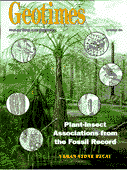 |
Plant-Insect Associations |
 |
Plant-Insect Associations |
| September 1998 | Table of Contents | Volume 43 | Number 9 |
|
|
|
 |
|
|
|
|
|
|
|
|
|
|
|
|
|
|
|
Iron, iron everywhere, but not at Big Sur ... Sediments douse fire theory ... Redefining the Ocean Drilling Program ... Slipping away on Venus ... Cold War's hot technology ... A king's supper ... Disaster warnings in real time ... Getting to the core of climate change
POLITICAL SCENE
Lobbying and the Geoscience Community
David Applegate
FEATURES
Plant-Insect Associations from the Fossil Record
by Conrad C. Labandeira
A curator from the Smithsonian's National Museum of Natural History
studies the fossil record to document the complex relationship between
plants and their insect predators. Examining types of flora and insect
herbivores can establish whether some insect and plant lineages are ancient
associations or whether older associations were swamped repeatedly by evolving
species.
The Complexity of Urban Stone Decay
by Erhard M. Winkler
Since the beginning of the Industrial Revolution, the rate of most
types of stone decay has increased dramatically, particularly in urban
areas. A professor emeritus from the University of Notre Dame describes
the effects of acid rain, humidity, salts, and other elements on buildings
and infrastructures in a variety of climates.
See the related press release describing
the September issue.
 © 1998 American Geological Institute. All rights reserved.
Any copying, redistribution or retransmission of any of the contents of
this service without the express written consent of the American Geological
Institute is expressly prohibited.
© 1998 American Geological Institute. All rights reserved.
Any copying, redistribution or retransmission of any of the contents of
this service without the express written consent of the American Geological
Institute is expressly prohibited.
September Geotimes cover:
The Late Pennsylvanian coal-swamp forest at Berryville, Illinois Basin,
reconstructed from coal-ball permineralizations. The dominant tree-fern
Psaronius is depicted at center and the subdominant seed-fern Medullosa
is at left. Pole-like sigillarian lycopods are in the background. Inferred
consumers of Psaronius include trunk detritivores such as oribatid
mite borers of the root mantle at lower left and a cockroach-like stem
borer at lower right, and canopy insect herbivores such as (in clockwise
order, beginning center left) a larval holometabolous galler, protorthopteran
external foliage feeder (upper left), nymphal paleodictyopteroid spore
imbiber (upper right), and an adult paleodictyopteroid piercer-and-sucker
(center right).
Illustration by Mary Parrish.